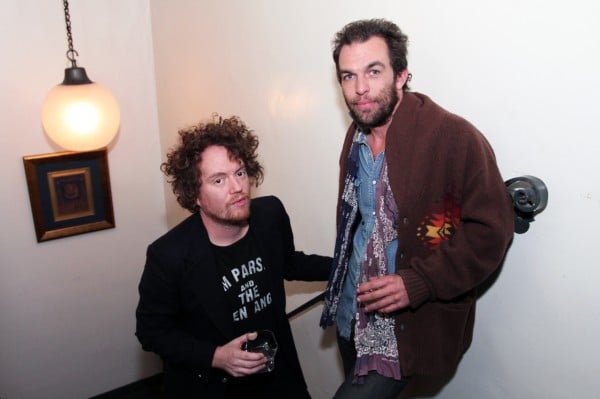
Photo: James Yeh.
On Monday, during the set-up of their new installation What’s the Alternative at the Ace Hotel in New York, artists Jonah Freeman and Justin Lowe were fine-tuning the lighting. “I like this cross-fader because it makes it look less like a nightclub,” said Freeman about the overhead lights shining onto a patterned mirror. He was standing about 15 feet away from the mirror with a look of contemplation. Freeman mentions that this is their first “light show.”
Known for their dark and intricate environments referencing film and drug culture (their first collaboration was a recreation of a meth lab), often presented as a series of shabby but precisely arranged interconnected rooms that look like deserted sets, the collaborative duo ordinarily encourage viewers to walk through and examine the spaces, taking in the torn walls and dirty couches at their leisure. Here, however, the art duo are doing something different.
Using the extensive lighting system available at the Ace Hotel, they’ve programmed a lighting sequence timed to direct the viewer’s gaze, to try and suggest in a somewhat cinematic way what someone should be looking at and for how long. It’s a bit like making a visual-spatial-audio playlist.
The installation, which opens tonight with an invitation only performance by indie-rock band and frequent Freeman and Lowe collaborators Psychic Ills, is connected to Paul Thomas Anderson’s newly released psychedelic surf-noir Inherent Vice, based on Thomas Pynchon’s 2009 novel of the same name.
As preprogrammed lights fade in and out, spotlighting various works in green, purple, and yellow hues, Lowe watches from one of two small benches in the center of the space. Every now and then he steals a bite of his lunch, a chicken wrap he’s brought down from the hotel restaurant. In the opened doorway of what appears to be a supply closet, replete with stacks of folding chairs, a female mannequin sports a Happy New Year tiara and a T-shirt with an airbrushed girl-on-girl scene, outlined in florescent, glow-in-the-dark ink. On cue, blue-and-red lights wash over the mannequin and fog pours across its torso.
A vibey eight-minute track by Spacemen three plays on loop and Freeman makes a suggestion. “This looks good, but there’s still some glare on these,” he says, and the hotel’s resident light-and-sound expert Ben Bromley repositions an eight-foot-tall light stand into the corner. He adjusts the aperture over the light focused on a magazine rack featuring editions of Artichoke Underground, Freeman and Lowe’s fictional alternate-universe fanzine.
Photo: James Yeh.
At one point during my visit, Lowe takes a call from the Marlborough Gallery, where the duo’s most recent work, Floating Chain (Hi-Res Toni), an homage to Italian architecture collective Superstudio that is comprised of rooms papered in psychedelic patterns and decked out with furnishings including floral-printed chairs, a rotary telephones, and a toy flute, recently closed. Apparently, some of it was still there, and it’s causing something of a logjam. “I think we should keep the books and dump the rest,” Lowe says, referring to their celebrated alternate-universe library. Freeman adds, “Tell them we also want the helmet.”
When asked how the multidimensional nature of Inherent Vice—the Pynchon novel, the P. T. Anderson comedy, and the soundtrack by Jonny Greenwood of Radiohead—informed the installation, Lowe says it was a bit like British conceptual artist Liam Gillick’s idea of parallel practice. He cites his admiration for “Pynchon’s paranoid, overlapping, tangential narratives” and P. T. Anderson’s work as a whole. “The pairing made sense,” he says. “I mean, I read the book. I saw the movie. But I was going to do that anyway, you know?”
Though their work is related to the film, oddly, there are no re-creations from the film or even any allusions to it. The artists were obligated to sign a contract with Warner Brothers concerning any materials that made a direct reference to the film. (If, for instance, they wanted to make a fake Inherent Vice poster, the studio would need to be consulted. If the poster sold, the studio would likely receive a cut.)
There are, however, several preexisting nods to Pynchon. Three volumes on the bookshelf reference Trystero, the secret underground postal-delivery service in Pynchon’s novella The Crying of Lot 49, and on one of the covers of Artichoke Underground it reads: “Thomas Pynchon interviewing Governor Ronald Reagan.” Freeman says this is an allusion to English science-fiction writer J. G. Ballard’s controversial 1968 pamphlet Why I Want to Fuck Ronald Reagan.
“We’re finding the perfect choreography, which has to do with not only the duration of the lighting but the order,” says Lowe. We return to our conversation about novels and tangential narratives—Pynchon, yes, Lowe says, but also David Foster Wallace and Herman Melville, those chapters in Moby-Dick devoted to the many uses of whale blubber, comparisons of different whale heads, a mini-treatise on different cultures’ views on “whiteness.” “The plot is all the parts it’s made of,” he says. He may as well be talking about his and Freeman’s own work, too.